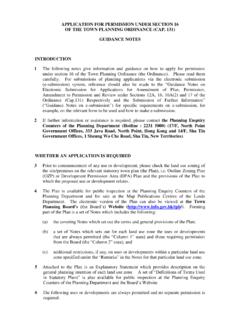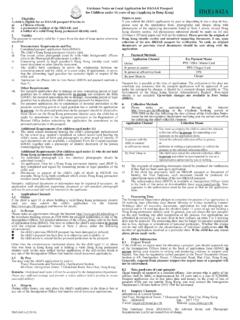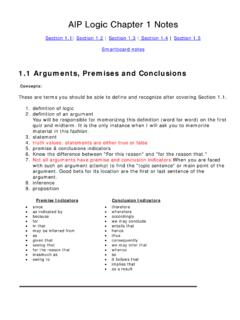Transcription of Imbens/Wooldridge, Lecture Notes 1, Summer ’07
1 imbens / wooldridge , Lecture Notes 1, Summer 071 What s New in EconometricsNBER, Summer 2007 Lecture 1, Monday, July 30th, of Average Treatment Effects Under Unconfoundedness1. IntroductionIn this Lecture we look at several methods for estimating average effects of a program,treatment, or regime, under unconfoundedness. The settingis one with a binary traditional example in economics is that of a labor market program where some individ-uals receive training and others do not, and interest is in some measure of the effectivenessof the training. Unconfoundedness, a term coined by Rubin (1990), refers to the case where(non-parametrically) adjusting for differences in a fixed set of covariates removes biases incomparisons between treated and control units, thus allowing for a causal interpretation ofthose adjusted differences.
2 This is perhaps the most important special case for estimatingaverage treatment effects in practice. Alternatives typically involves strong assumptions link-ing unobservables to observables in specific ways in order toallow adjusting for the relevantdifferences in unobserved variables. An example of such a strategy is instrumental variables,which will be discussed in Lecture 3. A second example that does not involve additionalassumptions is the bounds approach developed by Manski (1990, 2003).Under the specific assumptions we make in this setting, the population average treat-ment effect can be estimated at the standard parametric Nrate without functional formassumptions. A variety of estimators, at first sight quite different, have been proposed forimplementing this.
3 The estimators include regression estimators, propensity score based es-timators and matching estimators. Many of these are used in practice, although rarely isthis choice motivated by principled arguments. In practicethe differences between the esti-mators are relatively minor when applied appropriately, although matching in combinationwith regression is generally more robust and is probably therecommended choice. More im-portant than the choice of estimator are two other issues. Both involve analyses of the datawithout the outcome variable. First, one should carefully check the extent of the overlapImbens/ wooldridge , Lecture Notes 1, Summer 072in covariate distributions between the treatment and control groups. Often there is a needfor some trimming based on the covariate values if the original sample is not well this, estimates of average treatment effects can be very sensitive to the choice of,and small changes in the implementation of, the this part of the analysisthe propensity score plays an important role.
4 Second, it is useful to do some assessment ofthe appropriateness of the unconfoundedness assumption. Although this assumption is notdirectly testable, its plausibility can often be assessed using lagged values of the outcome aspseudo outcomes. Another issue is variance estimation. Formatching estimators bootstrap-ping, although widely used, has been shown to be invalid. We discuss general methods forestimating the conditional variance that do not involve these Notes we first set up the basic framework and state thecritical assumptions inSection 2. In Section 3 we describe the leading estimators. In Section 4 we discuss varianceestimation. In Section 5 we discuss assessing one of the critical assumptions, unconfounded-ness. In Section 6 we discuss dealing with a major problem in practice, lack of overlap in thecovariate distributions among treated and controls.
5 In Section 7 we illustrate some of themethods using a well known data set in this literature, originally put together by Lalonde(1986).In these Notes we focus on estimation and inference for treatment effects. We do not dis-cuss here a recent literature that has taken the next logicalstep in the evaluation literature,namely the optimal assignment of individuals to treatmentsbased on limited (sample) in-formation regarding the efficacy of the treatments. See Manski (2004, 2005, Dehejia (2004),Hirano and Porter (2005).2. FrameworkThe modern set up in this literature is based on the potentialoutcome approach developedby Rubin (1974, 1977, 1978), which view causal effects as comparisons of potential outcomesdefined on the same unit. In this section we lay out the basic DefinitionsImbens/ wooldridge , Lecture Notes 1, Summer 073We observeNunits, indexed byi= 1.)
6 ,N, viewed as drawn randomly from a largepopulation. We postulate the existence for each unit of a pair of potential outcomes,Yi(0)for the outcome under the control treatment andYi(1) for the outcome under the activetreatment. In addition, each unit has a vector of characteristics, referred to as covariates,pretreatment variables or exogenous variables, and denoted is important thatthese variables are not affected by the treatment. Often theytake their values prior to theunit being exposed to the treatment, although this is not sufficient for the conditions theyneed to satisfy. Importantly, this vector of covariates caninclude lagged outcomes. Finally,each unit is exposed to a single treatment;Wi= 0 if unitireceives the control treatmentandWi= 1 if unitireceives the active treatment.
7 We therefore observe for each unit thetriple (Wi,Yi,Xi), whereYiis the realized outcome:Yi Yi(Wi) ={Yi(0) ifWi= 0,Yi(1) ifWi= of (Wi,Yi,Xi) refer to the distribution induced by the random sampling fromthe additional pieces of notation will be useful in the remainder of these Notes . First,the propensity score (Rosenbaum and Rubin, 1983) is defined as the conditional probabilityof receiving the treatment,e(x) = Pr(Wi= 1|Xi=x) =E[Wi|Xi=x].Also, define, forw {0,1}, the two conditional regression and variance functions: w(x) =E[Yi(w)|Xi=x], 2w(x) =V(Yi(w)|Xi=x). Estimands: Average Treatment Effects1 Calling such variables exogenous is somewhat at odds with several formal definitions of exogeneity( , Engle, Hendry and Richard, 1974), as knowledge of their distribution can be informative about theaverage treatment effects.}
8 It does, however, agree with common usage. See for example, Manski, Sandefur,McLanahan, and Powers (1992, p. 28). imbens / wooldridge , Lecture Notes 1, Summer 074In this discussion we will primarily focus on a number of average treatment effects (ATEs).For a discussion of testing for the presence of any treatmenteffects under unconfoundednesssee Crump, Hotz, imbens and Mitnik (2007). Focusing on average effects is less limitingthan it may seem, however, as this includes averages of arbitrary transformations of theoriginal first estimand, and the most commonly studied in the econometricliterature, is the population average treatment effect (PATE): P=E[Yi(1) Yi(0)].Alternatively we may be interested in the population average treatment effect for the treated(PATT, , Rubin, 1977; Heckman and Robb, 1984): P,T=E[Yi(1) Yi(0)|W= 1].
9 Most of the discussion in these Notes will focus on P, with extensions to P,Tavailable inthe will also look at sample average versions of these two population measures. Theseestimands focus on the average of the treatment effect in the specific sample, rather than inthe population at large. These include, the sample average treatment effect (SATE) and thesample average treatment effect for the treated (SATT): S=1NN i=1(Yi(1) Yi(0)),and S,T=1NT i:Wi=1(Yi(1) Yi(0)),whereNT= Ni=1 Wiis the number of treated units. The sample average treatmenteffectshave received little attention in the recent econometric literature, although it has a longtradition in the analysis of randomized experiments ( ,Neyman, 1923). Without furtherassumptions, the sample contains no information about the population ATE beyond the2 Lehman (1974) and Doksum (1974) introduce quantile treatment effects as the difference in quantilesbetween the two marginal treated and control outcome distributions.
10 Bitler, Gelbach and Hoynes (2002)estimate these in a randomized evaluation of a social program. Firpo (2003) develops an estimator for suchquantiles under , Lecture Notes 1, Summer 075sample ATE. To see this, consider the case where we observe the sample (Yi(0),Yi(1),Wi,Xi),i= 1,..,N; that is, we observe for each unit both potential outcomes. In that case thesample average treatment effect, S= i(Yi(1) Yi(0))/N, can be estimated without the best estimator for the population average effect, P, is S. However, we cannotestimate Pwithout error even with a sample where all potential outcomes are observed,because we lack the potential outcomes for those populationmembers not included in thesample. This simple argument has two implications. First, one can estimate the sample ATEat least as accurately as the population ATE, and typically more so.













